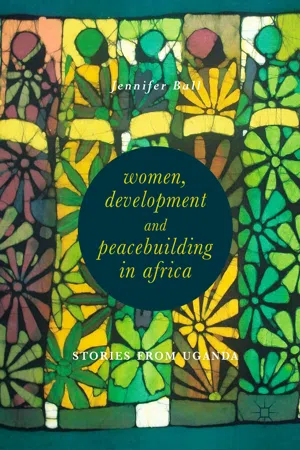Women and Peacebuilding
Peacebuilding, as defined by most mainstream literature and international policies, refers to processes and activities engaged in during periods of post-conflict reconstruction. Peacebuilding in this sense follows on the efforts of peacemaking and peacekeeping , those interventions designed to end the violence and negotiate an agreement or resolution, thereby enabling the rebuilding of societal infrastructure (Ball and Halevy 1996; Boutros-Ghali 1992, 1995; Jeong 2000, 2002a; Porter 2007). Peacebuilding, from this perspective, is limited in time and space, in scope, and in those deemed to be doing peacebuilding. These peacebuilders are generally outsiders, often Westerners, whose mandate and concern are to intervene and assist in situations of protracted violent conflict (Jeong 2002b; Lederach and Jenner 2002; Reynolds and Paffenholz 2001).
An alternative and more holistic definition of peacebuilding understands this concept to encompass all aspects of life and all stages of conflict —pre-conflict, the actual conflict , and post-conflict—and so is inclusive of activities of prevention, resolution, and reconstruction. It recognizes the importance not only of the resolution of conflict and the rebuilding of physical infrastructure, but also the cultivation, nurturance, and transformation of the overall context in which conflict is embedded. The focus thus is not merely on ending violence (negative peace) but also on creating and ensuring the socioeconomic and political conditions in which people’s rights and basic human needs can be protected and met (positive peace) (Burton 1990; Galtung 1996; Lederach 1995, 1997, 2003; Maiese 2003; Mazurana and McKay 1999; Moshe 2001; Reardon 1993; Schirch 2004; Strickland and Duvvury 2003). Such is the interconnection between peacebuilding and development (Moshe 2001; Moosa et al. 2013; Paffenholz et al. 2005; UNESCO 2002).
Women are actively engaged in peacebuilding at every level, from the grassroots to the international arena. However, their work is often not made visible, and thus their voices and perspectives are sometimes not heard or regarded as credible (Erzurum and Eren 2014; Mazurana and McKay 1999; McKay 2002; McKay and de la Rey 2001; Moosa et al. 2013; Strickland and Duvvury 2003). This is partly because the majority of women’s involvement is found at the grassroots or local community level, but also because women themselves often do not view their work as peacebuilding—it is more informal and is seen as part of their social roles and responsibilities. Because of this, “women’s contributions tend to be undervalued and not readily incorporated or sought by many practitioners of peacebuilding” (Strickland and Duvvury 2003, p. 7). They do not often influence higher level policy development and decision-making. This book hopes to redress some of that undervaluing by bringing the voices of women peacebuilders to the fore.
Women have long been associated with peace. This is in large part due to their role as mothers —those who give and protect life—and their perceived embodiment of “feminine” values of nurturance, compassion, communalism, and collaboration (Boulding 2000, 2002; Charlesworth 2008; Reardon 1993). While holding some truth, these theories of biological predisposition and cultural socialization fail to recognize the diversity of identities within and among women along lines of age, race, class, ethnicity, language, religion, and ability. They also set up a polarization in which men are associated with war and violence as they live out more “masculine” values of dominance, aggression, and competition. Such dichotomies make peace the purview of women only, denying the reality that men are capable of taking on caregiver roles or may be socialized in more “feminine” values, and essentially abdicating men from their responsibility toward building peace (Boulding 2000; Dipio 2004; Reardon 1993; Vincent 2003). As peace requires the transformation of whole societies, it necessitates the involvement of both men and women.
That being said, women are known to lead the way in peace initiatives (Boulding 2000; Reardon 1993). While sorely underrepresented at higher levels of decision-making, women are disproportionately represented in peacebuilding efforts at the grassroots level (Mazurana and McKay 1999; Porter 2003; Sorensen 1998). Their roles and contributions have, however, only been recognized at international policy levels since 2000, in the passing of the United Nations Resolution 1325 on “Women, Peace, and Security.” This disconnect between the on-the-ground reality and what is reflected in national and international policies, programs, and funding allocations is in large part due to the gender inequality and corresponding power imbalances inherent in global and societal structures and institutions (Baksh et al. 2005; Erzurum and Eren 2014; Reardon 1993; Rehn and Johnson Sirleaf 2002b).
Women’s perspectives, needs, and contributions in areas of conflict and peacebuilding have not historically been solicited, profiled, or incorporated into the policy and program decisions directly affecting them. Years of advocacy by women’s groups have, in the last decade, resulted in a growing realization of the significance of a gendered perspective to peacebuilding. The field of peacebuilding, in this way, builds on a similar evolution of and discourse within the field of development.
International development originally operated from an assumption that “gender neutrality” had no differentiated impacts on men or women but provided benefit to all. The effects of gender inequality , inevitably a part of every society, were not taken into consideration. As York (1998, p. 23) reminds us, “women—who comprise the majority of the poor, who constitute more than half the world’s population, and who do two-thirds of the labor—make only one-tenth of the money and own only one-hundredth of the property.”
Such realities became more apparent through the critique of feminist researchers, leading to a series of paradigm shifts in the field from women in development (WID) to women and development (WAD) to gender and development (GAD) to women, environment, and development (WED) and, more recently, to women’s economic empowerment (WEE) (Strickland and Duvvury 2003; Yusufu 2000; de Haan 2017)—all aimed at promoting greater awareness of and intentionality toward gender equity and women’s participation in and empowerment through development. Pankhurst (2003, 2004) notes, however, that gender mainstreaming in development is fundamentally related to a realization of its impact on the overall “efficiency” and su...
